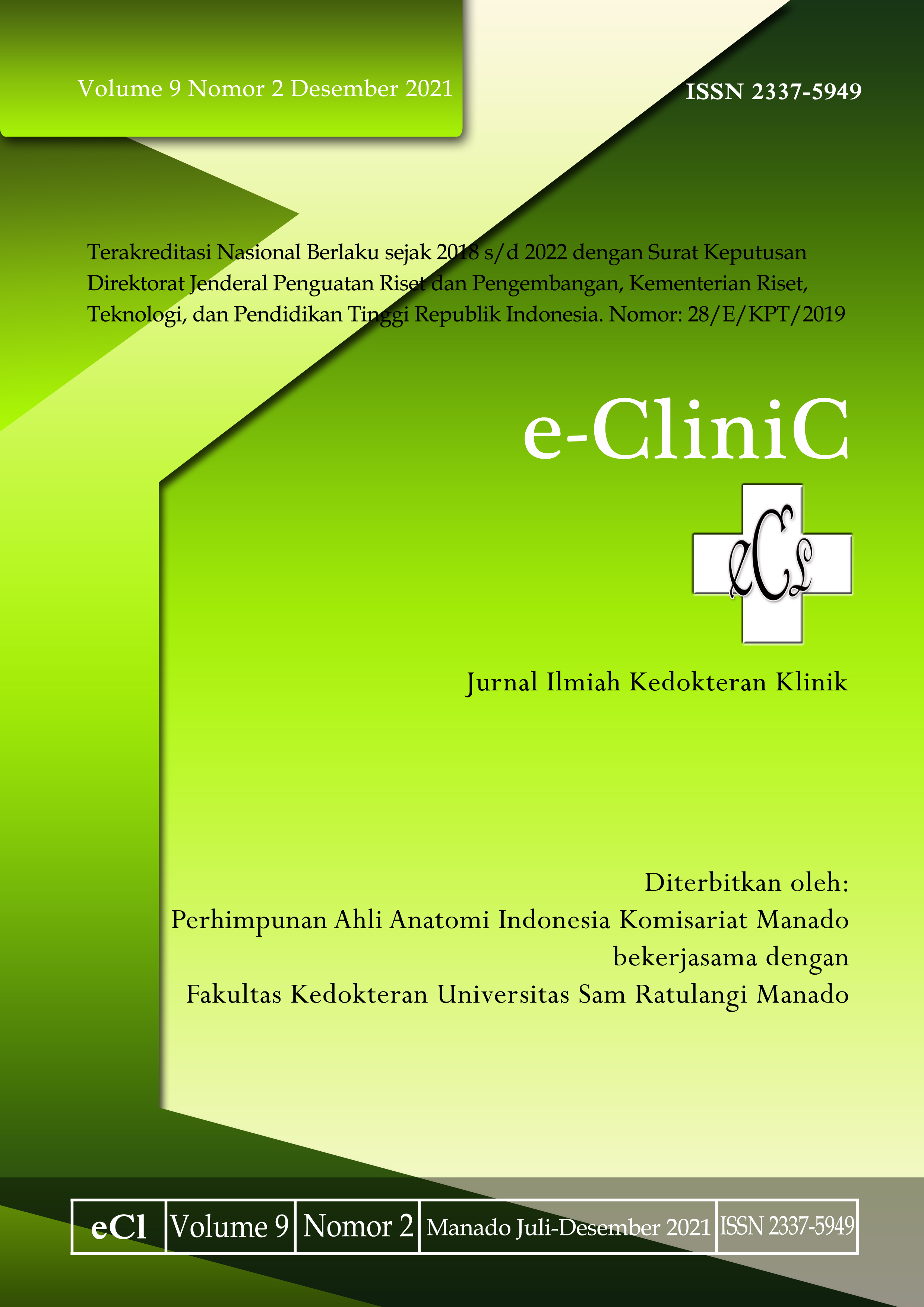Trauma Okular oleh Serangan Kerbau – Laporan Kasus
DOI:
https://doi.org/10.35790/ecl.v9i2.33847Abstract
Abstract: Of the many ocular blunt traumas, trauma due to typical buffalo attack thrrough leverage has not been reported. We reported a 65-year-old man attacked by a buffalo on his left eye. The patients complained of pain of his left eye associated with swelling, bleeding, and blurred vision. Eye examination revealed that visual acuity of the left eye was classified as hand motion (HM), limited ocular motility, blepharospasm, and a crescent-shaped anterior lamella laceration with lateral canthal involvement. Anterior segment examination revealed bullous subconjunctival hemorrhage, corneal edema, and rosette-shaped opacification (RSO) of the lens. Head-CT showed traumatic cataract and periorbital haemorrhage; no abnormalities in the right eye. Ovular trauma score (OTS) of the patient was three indicating that the possible visual prognosis was 2% as no light perception (NLP), 11% as light perception (LP) or hand motion (HM), 15% as 1/200-19/200, 31% as 20/200-20/50, and 41% as >20/40. Literature data showed that the visual sensitivity of OTS prediction in NLP, 20/200-20/50, and 20/40 was 100%. The specificity of OTS in predicting vision in LP/HM 1/200-19/200 was 100%. After a recovery period of approximately two months and the sutured wound healed, the patient came to the eye clinic of Prof. Dr. R. D. Kandou Hospital Manado. After a cataract surgery was performed on the left eye of the patient, his visual acuity improved to 20/40.
Keywords: ocular trauma, buffalo attack, ocular trauma score (OTS)
 Â
Abstrak: Dari sekian banyaknya trauma tumpul, trauma akibat rudapaksa tipikal serangan kerbau yang menggunakan gaya ungkit belum pernah dilaporkan. Kami melaorkan seorang laki-laki berusia 65 tahun yang mendapat serangan kerbau pada mata kiri dengan keluhan nyeri disertai pembengkakan, pendarahan, dan penglihatan kabur. Pemeriksaan mata menunjukkan ketajaman visual mata kiri dengan gerakan tangan, motilitas okular terbatas, blefarospasme, dan laserasi lamela anterior berbentuk bulan sabit dengan keterlibatan kantal lateral. Pemeriksaan segmen anterior menunjukkan perdarahan subkonjungtiva bulosa, edema kornea, dan rosette-shaped opacification (RSO) pada lensa. Hasil CT-kepala menunjukkan katarak traumatik dan perdarahan periorbital, tanpa kelainan pada mata kanan. Skor trauma okular pasien (OTS) ialah tiga yang menandakan kemungkinan prognosis pada visual pasien ialah 2% menjadi no light perception (NLP), 11% menjadi light perception (LP) atau hand motion (HM), 15% menjadi 1/200-19/200, 31% menjadi 20/200-20/50, dan 41% menjadi >20/40. Penggunaan OTS pada kasus ini karena data literatur menunjukkan bahwa sensitivitas penglihatan prediksi OTS di NLP, 20/200-20/50, dan 20/40 ialah 100%. Kekhususan OTS dalam memrediksi visi di LP/HM 1/200-19/200 ialah 100%. Setelah masa pemulihan sekitar dua bulan dan luka penjahitan sembuh, pasien datang kontrol ke poliklinik mata RSUP Prof. Dr. R. D. Kandou Manado. Setelah dilakukan operasi katarak pada mata kiri didapatkan tajam penglihatan mata kiri pasien 20/40.
Kata kunci: trauma mata, serangan kerbau, ocular trauma score (OTS)
Downloads
Published
How to Cite
Issue
Section
License
COPYRIGHT
Authors who publish with this journal agree to the following terms:
Authors hold their copyright and grant this journal the privilege of first publication, with the work simultaneously licensed under a Creative Commons Attribution License that permits others to impart the work with an acknowledgment of the work's origin and initial publication by this journal.
Authors can enter into separate or additional contractual arrangements for the non-exclusive distribution of the journal's published version of the work (for example, post it to an institutional repository or publish it in a book), with an acknowledgment of its underlying publication in this journal.
Authors are permitted and encouraged to post their work online (for example, in institutional repositories or on their website) as it can lead to productive exchanges, as well as earlier and greater citation of the published work (See The Effect of Open Access).







